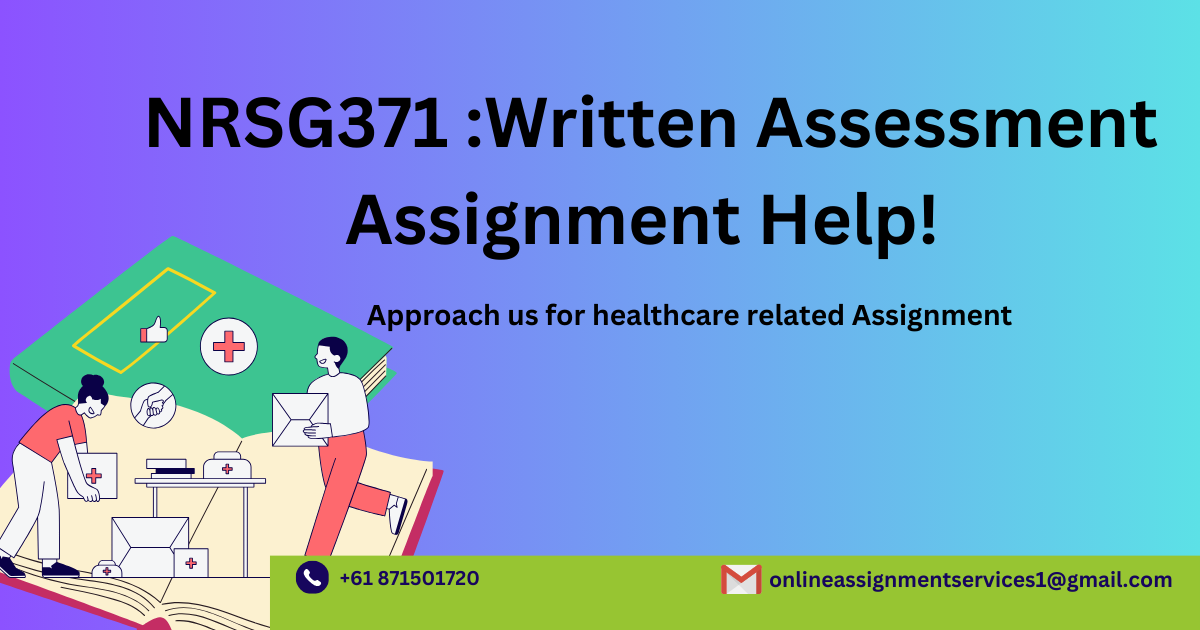NRSG371: Written Assessment Assignment Help

Question
NRSG371: In this written Assessment, students are required to craft an essay to explore the connection between nursing and community health by looking at health problems as a society issue. The assignment urges students to understand the vital role nurses play in building healthier societies and gain insights into the broader impact of nursing which extends beyond hospitals into the communities as a whole.
Solution
This assessment consists of two primary sections: Part “A” and Part “B”. Part “A” requires the student to select an Australian community, and highlight the distinctive features that the community holds. The students are needed to elaborate on the choice of this particular community from the provided list in relation to the chosen topic. Part “B” needs to explore how nurses can collaborate with the chosen community to address a chosen topic employing a strength-based approach. While the student needs to focus on addressing the selected critical topic linked to community well-being.

Our experienced experts have crafted a comprehensive guided sample on the topic “Insufficient Physical Activity Among Adults Aged 55-64 years in South Australia” to assist students grappling with the assignment. Presenting a 50% solution, we aim to demonstrate the expertise of our team in addressing every aspect of the assessment. Explore further for a glimpse into how our experts meet the assessment’s demands.
A sample of the essay is provided below. To read the entire essay, please reach out to us at +447700174710.
Introduction
The nursing profession has evolved significantly in the past century in response to changing societal demands. Specifically, nursing emphasis has shifted from acute, hospital-based care to involve health promotion, preventive screening, and disease prevention activities at the community level (Gottlieb, 2014). Nurses engage in community nursing with the aim of promoting, protecting, and preserving community health. Broadly defined, a community refers to a social system bound together by geography, shared beliefs, values, and interests. Goodman et al. (2014), suggested that the community functions as a multi-disciplinary collaborative enterprise whose collective efforts can be harnessed to promote health within the specific community group. To better understand the role of community nurses, the current essay will aim to explore a geographically defined community health issue, namely insufficient physical activity among adults aged 55-64 years living within the South Australia region. The essay will be divided into two key sections, Part A describes the characteristics and rationale of the selected community while Part B describes how nurses can work in collaboration with the community using the strength-based approach.
Insufficient Physical Activity Among Adults Aged 55-64 years in South Australia
South Australia is a state located within the southern region of Australia and is currently the fourth-largest state in the country. As of 2021, the total population of South Australia was estimated to be 1.783 million people (Australian Bureau of Statistics (ABS), 2022). According to estimates released by the ABS (2022), South Australia has the largest proportion of older adults above the age of 50, with 630,500 (37% of the population), being over 50 years of age. Specifically, the people aged 54 to 64 years are estimated to be 225,168 individuals (13% of the state population), including 49.3 percent male while 50.7% are female.
The adults aged 55-64 years were chosen as the most suitable group to study insufficient physical activity due to the recent rise and prevalence of adult overweight and obesity levels in SA, making it a public health concern (SA Health, 2022). The research denotes the lack of physical activity among adults aged 55-64 years as a risk factor for developing overweight and obesity in the community (SA Health, 2022). The average prevalence of Australian adults reporting minimal and sedentary levels of PA was 70% in 2020-2021, inclusive of 75.4 percent of men and 64.6 percent of women in the state (ABS, 2022). Physically inactive persons reported a higher percentage of the obese population of 48% which was significantly higher compared to 16% of physically active individuals in Australia (Wilson et al., 2019). Unfortunately, the lack of physical activity among adults aged 55 to 64 years of age has increased the risk of health problems in the age group. According to SA Health (2022), a higher body mass index increases the risk of heart disease, type 2 diabetes, cancer, mental health challenges, sleep deprivation, and joint problems.
The Australian Institute of Health and Welfare (2021), argued that lack of physical activity directly accounts for 20% of Type II diabetes levels, 12% of dementia, 16% of uterine cancer and 16% of heart disease. The Heart Foundation SA (2022), noted that South Australia had an above-national average level of cardiovascular diseases compared to other states. The ABS (2019) estimates reported that 25.4% of South Australians were more likely to have hypertension compared to 22.8 percent national average. In 2021, 10.2 % of adults aged 50-69 years were diagnosed with cardiovascular conditions while 12.0% were diagnosed with Type II diabetes in the same year (SA Health, 2022). Trends and prevalence in obesity and diabetes have therefore been linked to the rising levels of poor health outcomes among older adults, making health promotion within the age group a priority concern for health practitioners (Montgomerie et al., 2021). The weight-related complications place significant burden on the economic, health system and families of the affected individuals, also highlighting the need for targeted intervention. In the future, over 50% of individuals in South Australia are expected to be aged 50 and above, which makes it essential to promote healthy lifestyle practices in the group (ABS, 2019). Continued lack of physical inactivity among older adults will therefore mean more disease prevalence and health burden for families and healthcare resources in the state. Physical activity among middle-aged adults is a fundamental determinant of their health, wellness, and mobility. The World Health Organization’s (2022) recommendation for physical activity suggests that adults between the age of 18 to 64 years should engage in at least 150 minutes of moderate to intense activity each week. Adhering to the recommended levels of physical activity enhances physical health by boosting metabolism and also boosts immune responses towards viral infections (Baugh et al., 2022). More so, physical activity boosts the mental health of middle and older aged adults, allowing them to maintain cognitive functioning and psychological well-being for a longer period. Understanding how nurses can participate and enhance physical activity among older adults aged 55 to 64 years, will therefore offer a strong channel for preventing and managing disease and illness in the future.
This is only half the solution to elaborate how our experts provide detailed and well-researched assignments. Want to read the entire essay? Reach out to us at +61 871501720.

